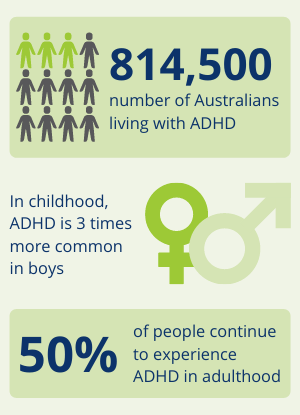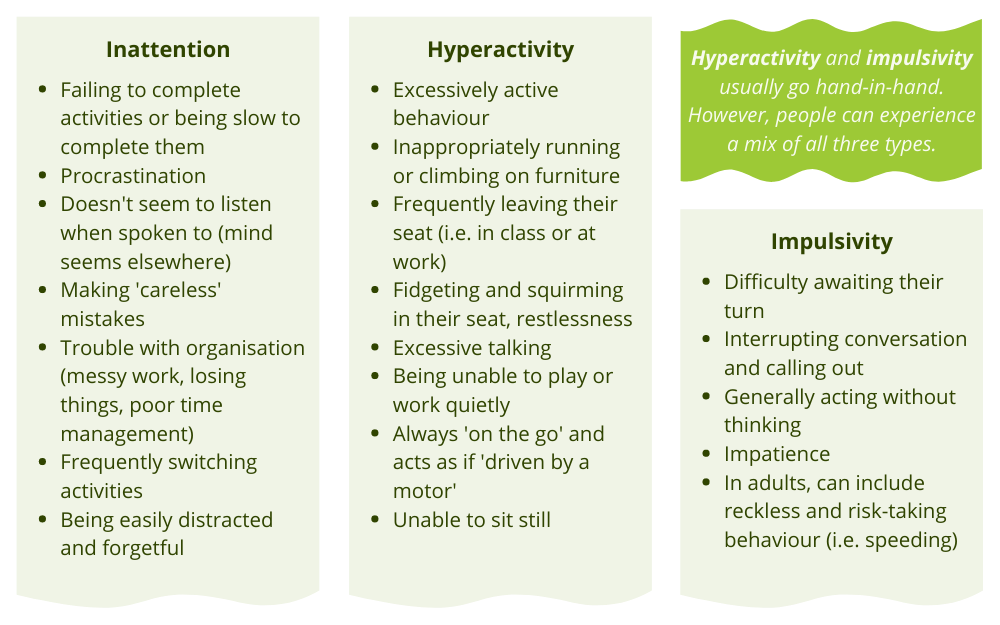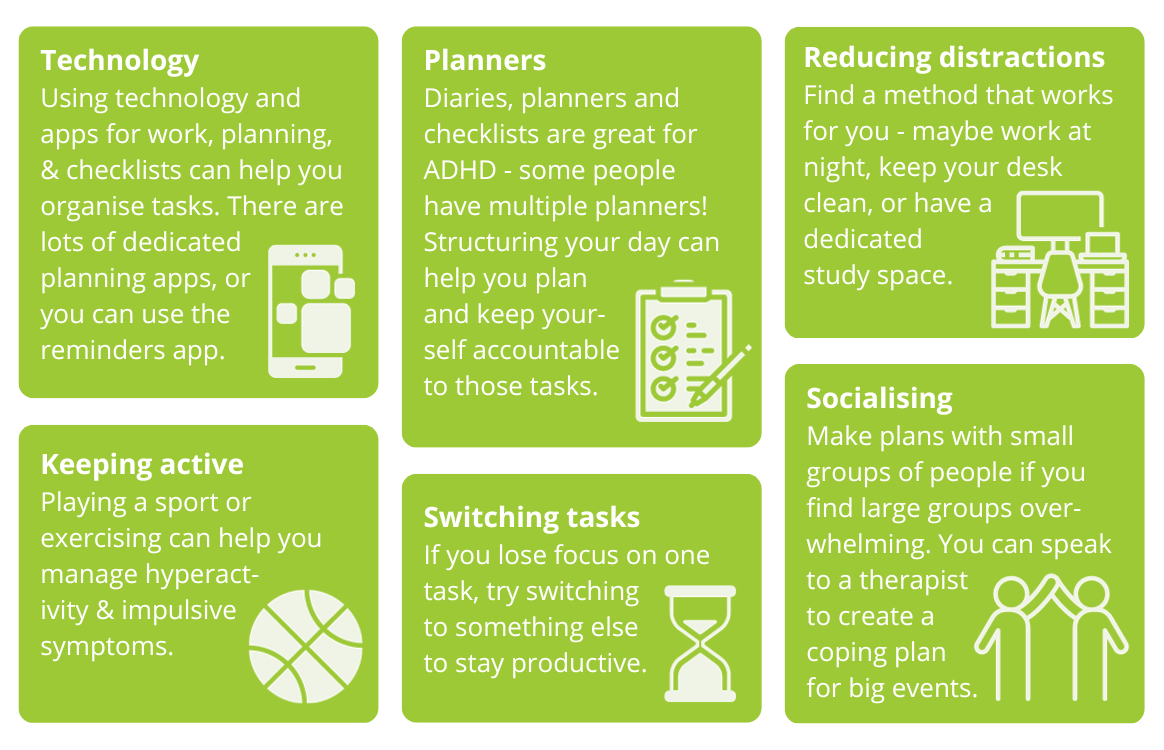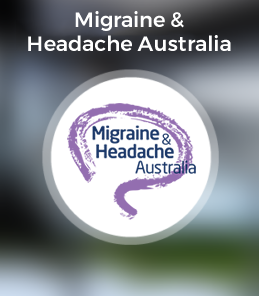Attention deficit hyperactivity disorder (ADHD) is a common neurodevelopmental disorder that can cause attention differences, hyperactivity, and impulsivity.
It is commonly first diagnosed in children but it can also not be detected until adulthood. ADHD persists into adulthood for most people. Symptoms vary from person to person, and they can change as you get older. There are a number of treatments and support strategies available to help support you and maximise your strengths.
Click the headings below to jump to specific sections.
- What is ADHD?
- Prevalence in Australia
- Signs & Symptoms
- Diagnosis
- Causes
- Support strategies & treatment
- ADHD in adults
- Outlook
- Further information & support
Medically reviewed by Dr Tamara May. Last updated November 28, 2023.
What is ADHD?
Attention deficit hyperactivity disorder (ADHD) is a common condition where people experience hyperactivity, impulsive behaviour, and difficulty focusing their attention. This can affect your life in many ways – at school or work, with friends, at home, and how you feel about yourself.
People are often diagnosed in childhood if their teachers notice a child is easily distracted, has difficulties focussing on their school work or sitting still. However, ADHD is a complex condition with a wide variety of characteristics, and not all children will fit this stereotype.
People can have only the inattentive presentation, where there are difficulties focusing and sustaining attention which can result in difficulties with organisation, following instructions, time management and forgetfulness. People with the hyperactive-impulsive presentation are constantly busy and fidgeting, have lots of energy, and can be impulsive including being overly talkative or having difficulties waiting their turn. Some people have the combined type – both hyperactive-impulsive and inattention symptoms.
Generally people with hyperactive-impulsive symptoms will be diagnosed earlier on as the traits are more obvious, while inattentive symptoms might be overlooked. But even if it is less noticeable to outsiders, both can be challenging to live with.
It’s important to remember that your symptoms aren’t due to ‘bad behaviour’ but instead are due to neurodevelopmental differences in the brain, and you can get support to live a happy and productive life. People with ADHD aren’t lazy, intentionally disobedient, or attention-seeking – your brain is just wired differently. Knowing what your traits are and finding a support plan that works for you can help you live a fulfilling life.
Prevalence in Australia
ADHD affects approximately 281,000 children and adolescents and 533,000 adults in Australia (6). It is the most common problem encountered in outpatient child and adolescent mental health settings.
The prevalence of ADHD changes slightly when considering gender, but not as much as was once thought. Until the late 90s, there was very little research on how ADHD appears in girls. We now know that girls may have more inattentive symptoms, which aren’t perceived to be as disruptive as hyperactivity or are often not noticed by others resulting in girls being underdiagnosed (3).

Some older studies found that boys were ten times more likely to have ADHD (3). More recent research shows that the gap is significantly smaller – it is approximately 2-3 times more common in boys and in adulthood, there is almost 1 girl to every 1 boy (6).
While some professionals question whether ADHD is overdiagnosed, the majority recognise that ADHD is underdiagnosed in the community (6, 15). It has become better identified in recent years, which is partly due to increased awareness and recognition (including more accurate diagnosis in girls). However, ADHD can also overlap with symptoms of other neurodevelopmental and psychiatric conditions. It’s important to rule out other conditions such as learning disabilities or anxiety disorders.
Signs & Symptoms
Many different symptoms are associated with ADHD. Some common signs include frequently:
- Not being able to sit still
- Being easily distracted
- Being forgetful or losing things
- Having trouble focusing or concentrating on tasks
- Making careless mistakes
It is completely normal for children to experience these occasionally, particularly when they are very young. However, a diagnosis is made when their symptoms of hyperactivity, impulsivity, and/or inattention are noticeably greater than expected for their age and significantly impact on their ability to study, participate in the community like playing sport, interact with others and complete activities at home like self-care tasks and chores. It is also important to note that symptoms can vary depending on the level of motivation of the person for the context. For example, video games which are highly exciting and responsive can result in a child who enjoys them being able to focus well; but completing homework on a topic they don’t care about can result in procrastination and an inability to focus on the task.
Presentations of ADHD
There are a range of different ADHD symptoms which can vary from person to person. There are three common presentations of ADHD:
- Predominantly hyperactive-impulsive presentation. Hyperactivity refers to excessive energy or movement, and impulsivity refers to making decisions without thinking of consequences. Younger children might run around the classroom or climb on furniture, adults may be restless and have a constantly busy mind.
- Predominantly inattentive presentation. Inattention refers to challenges with focusing, staying on task, and being organised. Someone with predominantly inattentive symptoms might be seen as a daydreamer.
- Combined presentation. A person has both inattentive and hyperactive symptoms that each reach the clinical threshold.
It’s important to understand your symptoms and how they may affect you. Educating yourself is the first step to help you to support yourself. This is also important if you are the parent of a child with ADHD, or a partner of an adult with ADHD. Parents can work with teachers to better engage them in class, and support them in homework tasks.
You can read more about the different ADHD symptoms in the graphic below (7,8).

Diagnosis
There is no single test for ADHD and confirming a diagnosis can be a complex process. Your doctor also needs to rule out other conditions that have similar symptoms (i.e. anxiety, sleep problems, learning disabilities).
Health professionals will perform an interview to explore ADHD symptoms and their impact on your life. In children this is often supported by assessments to exclude other conditions like neuropsychological testing, cognitive assessments, vision and hearing tests, or a checklist to rate your symptoms. They will also discuss your symptoms over the past six months. If the diagnosis is for a child, they will often consult with the child’s parents and school teachers. For adults, partners are often consulted.
Once other conditions have been ruled out, your doctor can make a diagnosis if you meet the criteria in the Diagnostic and Statistical Manual of Mental Disorders (DSM–5) (7):
- 6 or more symptoms are present, for over 6 months (only 5 symptoms are needed in people aged 17 or over).
- They are affected in 2 or more settings (i.e. at home and at school).
- Symptoms have negatively impacted academic, social, and/or occupational functioning.
- Symptoms started before 12 years of age.
- There isn’t a more accurate diagnosis in another psychiatric disorder (i.e. depression, anxiety), and the symptoms aren’t related to a psychotic disorder (i.e. schizophrenia).
- Symptoms aren’t a manifestation of oppositional behaviour or defiance of authority (in hyperactive-impulsive types).
In Australia, the diagnosis is usually made by a paediatrician, psychiatrist, or psychologist (10). You need to get a referral from a GP to see these specialists.
Causes
ADHD doesn’t have a single known cause, but we know some of the factors that play important roles (8). This includes:
- Family history
- Genetic differences
- Brain structure & function
- Environmental factors
- Cognition
This might seem like a broad range of risk factors, but this reflects the fact that ADHD is heterogenous. This means that people can experience different symptoms and levels of impairment even if they have the same type of ADHD (11).
Just as there are a variety of symptoms, there are various risk factors interacting with each other to influence ADHD development (11). This is part of the nature of ADHD (and many other psychiatric and neurodevelopmental disorders). There are dozens of genetic, environmental, and structural brain factors involved. Each of them play a small role individually, but collectively they can cause ADHD (11).
Family history
Family history is one of the most predictable risk factors for ADHD, with studies consistently showing that it runs in families (11). Parents and siblings of people with ADHD are 5-10 times more likely to also have it compared to the general population (4).
Genetic differences
There are a range of genetic variants which can cause symptoms of ADHD. The key systems affected are the dopamine, serotonin, and noradrenaline systems (4).
Some of these might sound familiar – dopamine plays a role in your brain’s pleasure and reward centre, and serotonin affects your mood. Noradrenaline affects how you respond to stress, including your ability to pay attention and focus. People with ADHD generally have a lower baseline level of these chemicals available in their brain (1). This is why you might find it hard to focus, or you get easily distracted while working on something you find difficult.
Brain structure & function
Imaging studies have shown that people with ADHD have physical and functional differences in their brain. This can be seen in several ways (4):
- Structural differences. Certain regions can be physically smaller than they should be, although this sometimes levels out as they get older.
- Overactivation or underactivation of neural networks. MRI studies have shown that some parts of the brain don’t respond as expected during certain tasks. Some networks were underactive (including those that help process information, complete goals, and focus), while others were more active than they should be (visual and motor systems).
- Resting-state brain function. Neural networks in people with ADHD behave differently even while resting. Researchers have found lower connectivity between the default-mode network (DMN) and the cognitive control network.
The findings from these imaging studies often vary, reflecting the heterogeneity of this disorder. This is consistent with broader studies on cognition (4).

Environmental factors
Environmental factors are one of the less predictable factors in ADHD. This is partially because it can be hard to separate a child’s upbringing and environment from their genetics and family history. However, some factors associated with ADHD include (4):
- Extremely Low birth weight
- Extremely Premature birth
- Environmental toxins (e.g. certain pesticides, polychlorinated biphenyls (these are banned in Australia), zinc, lead)
- Experiencing childhood trauma and abuse
Cognition
ADHD is characterised by differences in a number of cognitive areas (4). Some of the main cognitive functions that are affected include:
- Executive function
- Reward dysregulation – preferring immediate rather than delayed rewards, even if the delayed reward will be more valuable
- Timing – processing and planning any temporal information
- Memory span or working memory
Learning about how ADHD works can help you better understand your symptoms. In many ways, the ‘ADHD brain’ is literally wired differently. Understanding these differences can help inform your treatment or management strategies.
Support Strategies & Treatment
There are several options to support and treat ADHD. Stimulant medications are one of the most commonly used and most effective treatments. They are often used first and non-medication treatments can be used if further support is required to help other aspects of an individual’s functioning. Non-medication treatment options can include:
- Cognitive Behavioural therapy – this might include emotional education and social skills training
- Family counselling and support
- Parent skills training
- Educational strategies
This list isn’t comprehensive, but it just shows that many strategies can be used to help support ADHD. Combining medication and non-medication is known as ‘multimodal treatment’, and is often used for mental health conditions (12).
Supporting children with ADHD
Between home, school, and socialising, children might experience symptoms in many different ways. Strategies that work at home might not be applicable in school, or vice versa. It’s important to work with your child’s teachers and school to plan an environment where they are able to learn (10).

Parental training is also recommended, and research shows that it can improve parent-child relationships and reduce symptoms (4). This training usually involves educating you about ADHD, strategies to reduce symptoms, and your child’s development (8). You can also use positive parenting strategies, focusing on rewards for positive behaviours (8).
In all areas, it’s important to stick to a routine as much as possible (10). Establishing a routine can help children feel supported, and could also make it easier to identify progress when their treatment is working.
Treatment will also vary depending on your child’s age. For most school age children it is generally recommended that medication is used alongside positive strategies to improve a child and families functioning. Research suggests that this combination can have long-term benefits going into adulthood (4).
Treating ADHD in children is something that needs to be collaborative, flexible, and subject to change as they get older. They might experience symptoms in new ways as school gets more stressful or their social life changes. But with the support of parents, the school, and a paediatrician, psychiatrist or psychologist, most children can reduce the impact of their symptoms and thrive.
Medication
Stimulant medications are recommended as the most effective treatment for ADHD (4, 10). They have been thoroughly researched for many years and can improve concentration, impulse control, and reduce hyperactivity (10). Stimulants are also effective for a significant number of people – one study found that 70% of people respond to the first stimulant they try, and 90-95% will respond to a second one if the first fails (8).
In Australia, the most commonly used medications are:
- Dexamfetamine
- Lisdexamfetamine (Vyvanse)
- Methylphenidate (Ritalin or Concerta)
- Atomoxetine (non-stimulant option) (12)
Most of these are subsidised by the Pharmaceutical Benefits Scheme (PBS), reducing the cost.
Each medication is also available in different formulations. There are short (2-4 hours), intermediate (6-8 hours), and long-acting (10-12 hours) types, which enable clinicians to tailor your medication depending on your needs (4). For example, a primary school student might need a long-acting medication so that they don’t need to take a second dose while at school. Other people may prefer short-acting versions if they need to focus mostly in the afternoons, and don’t want it to interfere with sleep.
These choices are all very personal and will depend on your symptom severity, how you tolerate the medication, and your paediatrician or psychiatrist’s recommendations. It is often recommended that people take their medications seven days a week. Even if you don’t have school or work, it can help with maintaining a routine, socialising, driving, doing homework, and functioning in a household environment (4).
Are there side effects for ADHD medication?
The adverse effects associated with ADHD medication are quite mild. The doses and way the medication is administered aren’t addictive, and do not cause withdrawal symptoms (10). Some possible side effects include trouble sleeping, reduced appetite, and irritability (4).
These can normally be reduced through strategies, such as only taking your medication after eating. For sleep problems, people can improve their sleep routine, take their medication earlier or switch to a shorter acting formulation.
In children, a reduced appetite or disrupted sleep can be concerning for parents. Thankfully there have been studies assessing these side effects in children as well. While some children might have a slight delay in their growth in height, this usually evens out over time. Most children will reach their expected height and weight for adulthood, although you can consult their doctor if you notice changes in their growth (4).
If any of these side effects continue to interfere with your day-to-day life, you should ask your doctor for advice and discuss other options.
Non-medication management
Non-medication approaches are used to treat ADHD for many reasons. Sometimes people don’t respond to medication, or medications won’t help with all their symptoms (4). In other cases, there might be logistical barriers such as cost or access to a doctor.
Cognitive and behavioural interventions are widely recommended to help manage symptoms. Some strategies for children are discussed above, but there are options for people at all ages. A psychologist will often provide cognitive-behavioural therapy (CBT) for children and adults (4). CBT is a type of therapy that focuses on changing thought patterns and unhelpful behaviours, and helps you cope better (13).
Some skills and tools that are often discussed involve (4):
- Problem solving skills
- Compensatory strategies (adapting tasks or completing them in a different way to make it more manageable)
- Diaries and time schedules
- Social communication coaching
One study surveyed adults with ADHD to see what compensatory strategies they used to manage their symptoms (14).

The graphic above shows just a few ways that people adjust their life to reduce the impact of their symptoms. Many of these compensatory strategies can be applied in a number of different contexts. For example, task switching doesn’t mean you have to go from work emails to cleaning the house. You could break your work tasks into smaller pieces that use different skills, and switch between them if you find yourself getting distracted.
ADHD in adults
The majority of people diagnosed with ADHD in childhood will continue to have symptoms in adulthood (5). Hyperactive and impulsive symptoms often subside or become less obvious as you get older, while inattentiveness is likely to persist (1, 4).
There are also people who are not diagnosed in childhood and only realise they have ADHD much later in life. This might happen if you are predominantly inattentive or if your symptoms were mild in school, or you were in an environment where your symptoms were not triggered (for example you had a strong motivation for learning and had lots of structure to help you be organised and complete homework).
People with ADHD often discover new challenges in adult life, such as:
- Relationships
- Adjusting to the workplace
- Adjusting to living independently
- Addiction or substance misuse
Executive dysfunction can become more pronounced in adulthood as the person is less by parents and family and has to live independently. It affects things like (9):
- Attention – difficulty focusing or managing distractions.
- Working memory – this is basically how much information you can keep in mind to help you complete a task. Working memory deficits can make it hard to recall information in the moment or finish tasks that require higher order thinking (11).
- Planning & execution – difficulty with prioritisation, time management, follow-through, and starting or stopping activities.
- Measuring your progress – difficulty tracking your performance or progress with a task.
These symptoms affect many parts of your life, from everyday tasks like making appointments, to complex work projects or higher education (1). At times it can be very distressing to experience and you might feel as though things are out of control. However, ADHD can be successfully supported with a combination of lifestyle changes, non-medication and medication treatments.
Outlook
There is no doubt that ADHD can cause significant emotional, social, occupational and educational problems. While some children appear to ‘grow out of it’ at adolescence, it is a lifelong disorder for most people. Studies show that anywhere from 50-90% of people continue to experience symptoms into their late teens and young adulthood (5, 15).
With the help of timely and targeted interventions, most people learn how to function well as they get older (4). When ADHD is diagnosed and treated early, it can be effectively treated, so that you can grow to have a productive, successful and fulfilling life.
Further Information & Support
If you would like to learn more about ADHD, please consult the following resources and organisations.
Recent Australian ADHD research papers – access via PubMed >
ADHD Foundation Australia
The ADHD Foundation Australia provides national community support, referrals, information and services. They act as a central starting point, providing assistance to adults and families affected by ADHD who are struggling to get the help they need. The service offers support to medical professionals and allied staff when called upon.
Website: adhdfoundation.org.au
National support line: 1300 39 39 19
Support email: support@adhdfoundation.org.au
Office email: office@adhdfoundation.org.au
ADHD Australia
ADHD Australia’s vision is to make Australia a better place for people living with ADHD. They do this by creating systemic and positive change for people living with ADHD, by helping those that support them.
Website: www.adhdaustralia.org.au
Email: info@adhdaustralia.org.au
Australian ADHD Professionals Association (AADPA)
AADPA provides resources for people with ADHD and their families. It also has the Australian ADHD guideline where you can find out how you can be supported by ADHD professionals with factsheets for people with a lived experience of ADHD.
Website: https://aadpa.com.au/
Healthdirect
Trusted health information and advice online and over the phone (1800 022 222), available 24 hours a day, 7 days a week. Funded by the governments of Australia.
www.healthdirect.gov.au/attention-deficit-disorder-add-or-adhd
References:
- L Adler & H Chua, 2002, Management of ADHD in Adults. PMID: 12562059. Retrieved from: https://www.psychiatrist.com/pcc/management-adhd-adults/
- L Marshall [designer], 2015, ADHD. DOI: 10.1038/nrdp.2015.27
- F Mowlem et al, 2019, Do different factors influence whether girls versus boys meet ADHD T diagnostic criteria? Sex differences among children with high ADHD symptoms. DOI: 10.1016/j.psychres.2018.12.128
- S Faraone et al, 2015, Attention-deficit/hyperactivity disorder. DOI: 10.1038/nrdp.2015.20
- T Wilens et al, 2009, Presenting ADHD Symptoms, Subtypes, and Comorbid Disorders in Clinically Referred Adults with ADHD. DOI: 10.4088/JCP.08m04785pur
- Deloitte Access Economics, 2019, The social and economic costs of ADHD in Australia. Retrieved from: https://www.deloitte.com/au/en/services/economics/perspectives/social-economic-costs-adhd-Australia.html
- Centers for Disease Control and Prevention, 2023, Symptoms and Diagnosis of ADHD – DSM-5 Criteria for ADHD. Retrieved from: https://www.cdc.gov/ncbddd/adhd/diagnosis.html
- B Felt et al, 2014, Diagnosis and Management of ADHD in Children. PMID: 25369623. Retrieved from: https://pubmed.ncbi.nlm.nih.gov/25369623/
- F Castellanos et al, 2006, Characterizing cognition in ADHD: beyond executive dysfunction. DOI: 10.1016/j.tics.2006.01.011
- HealthDirect, 2023, Attention deficit hyperactivity disorder (ADHD). Retrieved from: https://www.healthdirect.gov.au/attention-deficit-disorder-add-or-adhd
- Y Luo et al, 2019, A Review of Heterogeneity in Attention Deficit/Hyperactivity Disorder (ADHD). DOI: 10.3389/fnhum.2019.00042
- NSW Health, 2023, ADHD – frequently asked questions. Retrieved from: https://www.health.nsw.gov.au/pharmaceutical/patients/Pages/faq-adhd-consumers.aspx
- American Psychological Association, 2017, What is Cognitive Behavioral Therapy?. https://www.apa.org/ptsd-guideline/patients-and-families/cognitive-behavioral
- C Canela et al, 2017, Skills and compensation strategies in adult ADHD – A qualitative study. DOI: 10.1371/journal.pone.0184964
- AADPA, 2022, Australian Evidence-Based Clinical Practice Guideline For Attention Deficit Hyperactivity Disorder (ADHD). Retrieved from: https://aadpa.com.au/australian-evidence-based-clinical-guideline-for-adhd/
DISCLAIMER: The information provided is designed to support, not replace, the relationship that exists between a patient / site visitor and his / her existing health care professionals.




 The Brain Foundation is the largest, independent funder of brain and spinal injury research in Australia. We believe research is the pathway to recovery.
The Brain Foundation is the largest, independent funder of brain and spinal injury research in Australia. We believe research is the pathway to recovery.